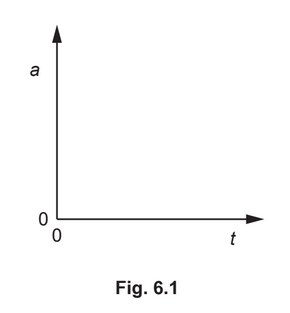Question
(a) A proton in a nucleus decays to form a neutron and a \(β^+\) particle.
(i) State the name of another lepton that is produced in the decay.
……………………………………………………………………………………………………………………. [1]
(ii) State the name of the interaction (force) that gives rise to this decay.
……………………………………………………………………………………………………………………. [1]
(iii) State which of the three particles (proton, neutron or \(β^+\) particle) has the largest ratio of
charge to mass.
……………………………………………………………………………………………………………………. [1]
(iv) Use the quark model to show that the charge on the proton is +e, where e is the
elementary charge.
[2]
(v) The quark composition of the proton is changed during the decay.
Describe the change to the quark composition.
………………………………………………………………………………………………………………………….
……………………………………………………………………………………………………………………. [1]
(b) A nucleus X ![]() and a nucleus Y
and a nucleus Y ![]() are accelerated by the same uniform electric field.
are accelerated by the same uniform electric field.
(i) Determine the ratio

ratio = …………………………………………………
(ii) Determine the ratio
ratio = …………………………………………………
(iii) Nucleus X is at rest in the uniform electric field at time t = 0.
The field causes nucleus X to accelerate so that it moves through the field.
On Fig. 6.1, sketch the variation with time t of the acceleration a of nucleus X due to the
field.
Answer/Explanation
Ans:
(a)(i) (electron) neutrino
(a)(ii) weak (nuclear force/interaction)
(a)(iii) \(β^+\) (particle)
(a)(iv) (quark structure is) up up down or uud
\((2 / 3)e + (2 / 3)e– (1 / 3)e = (+)e \)
(a)(v) up up down changes to up down down or uud→ udd
or
up changes to down or u→ d
(b)(i) F = Eq C
ratio = 6 / 8 = 0.75
(b)(ii) ratio = 0.75 × (16 / 12) = 1.0
(b)(iii) horizontal straight line at a non-zero value of a
Question
(a) A nucleus of sodium-22 ![]() decays by emitting a \(β^+\) particle. A different nucleus is formed by the decay.
decays by emitting a \(β^+\) particle. A different nucleus is formed by the decay.
(i) State the name of another lepton that is produced by the decay.
…………………………………………………………….. [1]
(ii) Determine the nucleon number and the proton number of the nucleus that is formed by the decay.
nucleon number = ………………………………………………………
proton number = ………………………………………………………
[2]
(iii) The quark composition of a nucleon in the sodium-22 nucleus is changed during the decay.
Describe the change to the quark composition of the nucleon.
………………………………………………………………………………
……………………………………………………………………………………… [1]
(b) A baryon consists of quarks that are the same flavour (type). The charge of the baryon is –2e, where e is the elementary charge.
(i) Calculate, in terms of e, the charge of each quark.
charge = ……………………………………………… e [1]
(ii) State a possible flavour (type) of the quarks.
………………………………………………………. [1] [Total: 6]
Answer/Explanation
Ans:
(a)(i) (electron) neutrino
(a)(ii) nucleon number = 22
proton number = 10
(a)(iii) up up down changes to up down down or up changes to down
(b)(i) charge = – 2⁄3e
(b)(ii) antiup / anticharm / antitop
